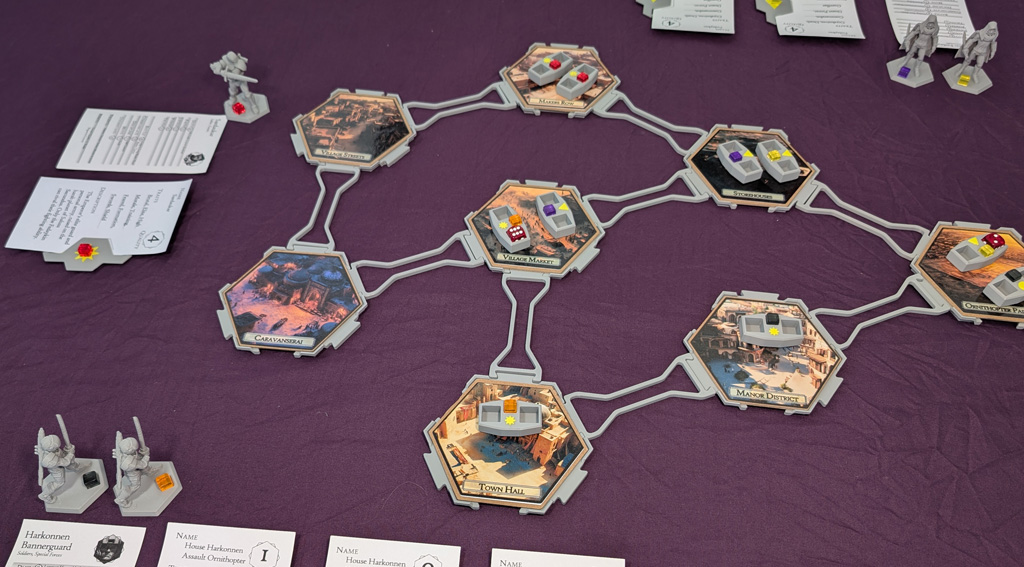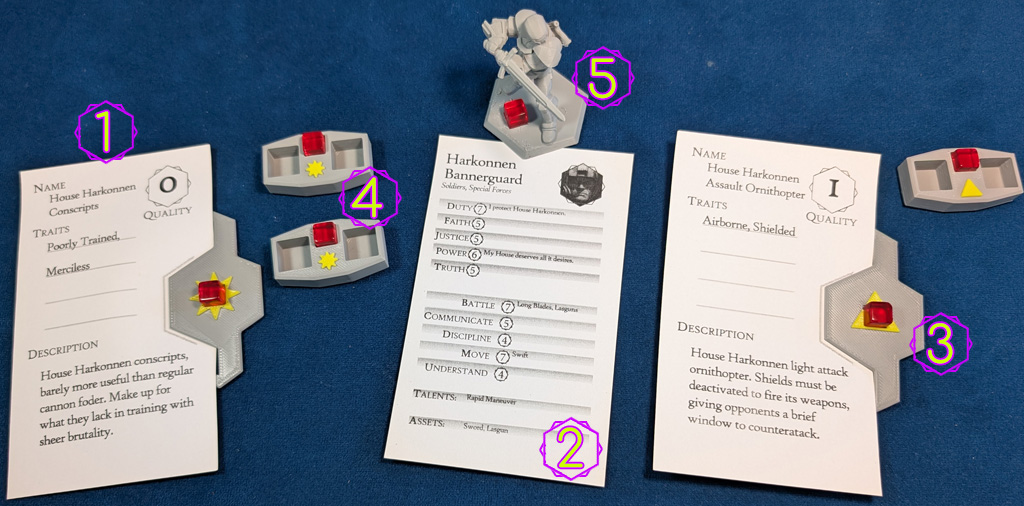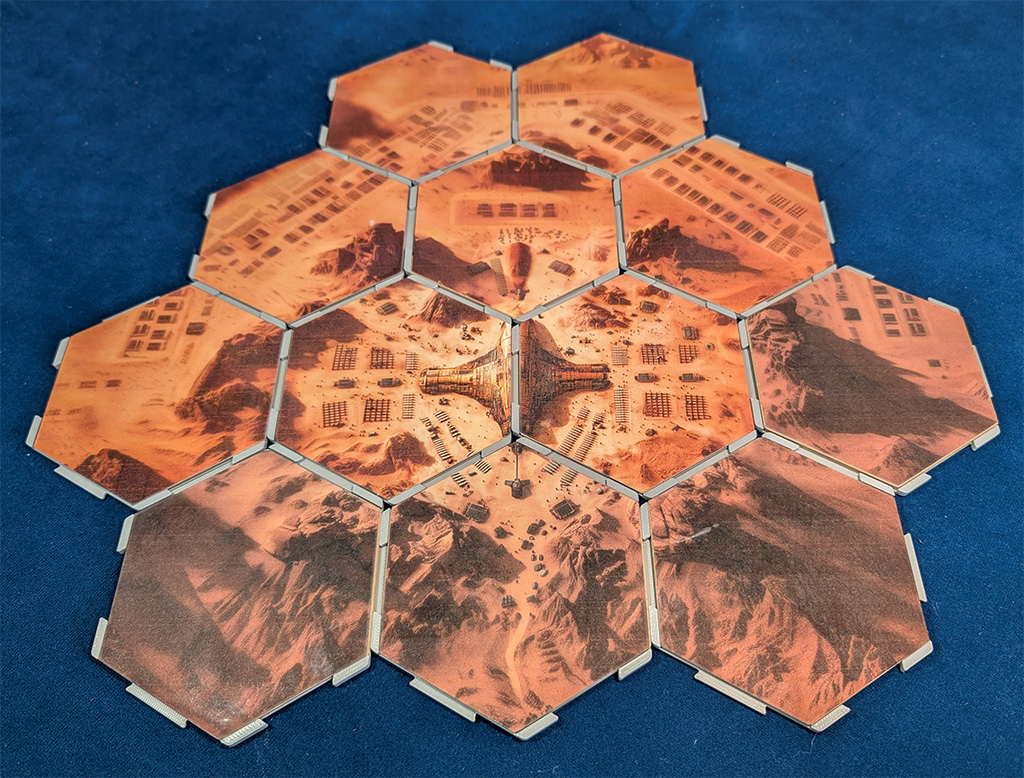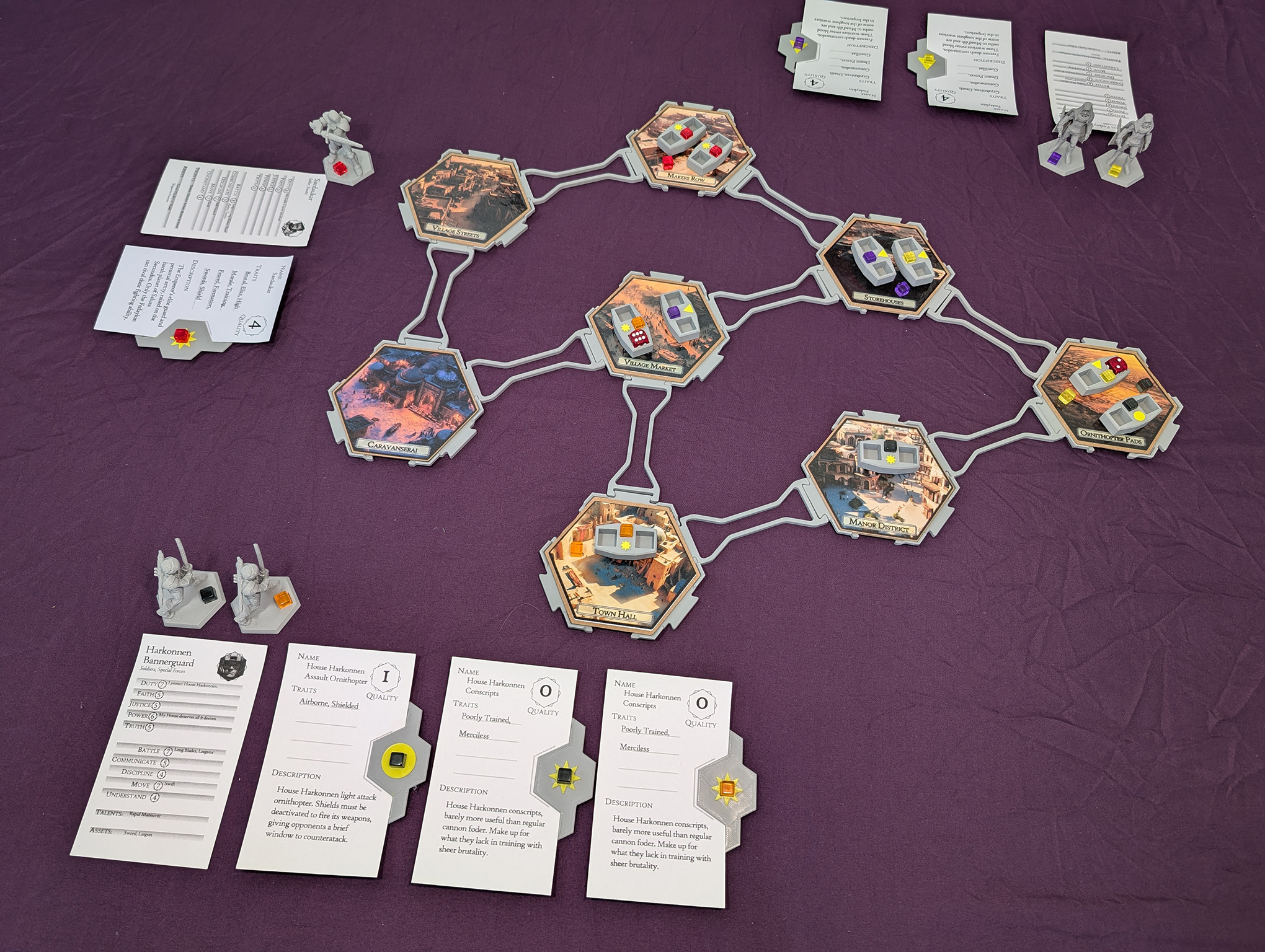
Posted August 8, 2025 by Martin
Translating a rich and complex warfare system into an easily manageable strategy experience on the tabletop
I want to preface this blog by saying that if you’re a roleplayer and even remotely interested in Frank Herbert’s Dune, you owe it to yourself to check out the Dune: Adventures in the Imperium roleplaying game by Modiphius right now. Their game represents one of the best translations of the source material into a playable format, capturing everything that makes the books (and the excellent movies directed by Denis Villeneuve) so great: intrigue, war, mysticism, and a distant future where the fate of humanity rests on the edge of a knife. I’m not being paid to say this; that’s all just my own humble opinion.
One of this particular system’s biggest accomplishments is its ability to model a wide range of conflicts from one-on-one duels all the way to planetary warfare using essentially one simple set of rules without feeling dumbed down or overly streamlined. Conflicts in the 2D20 system used in Dune: Adventures in the Imperium offer plenty of strategy, nuance, and opportunities to tell stories that feel right at home in the Dune universe.
I recently ran a campaign in this system, and everyone had a great time. When I was preparing the warfare scenarios for my campaign, I noticed that to truly bring the epic scale suggested by the system to life, I would need some extra tools to make the system sing. In the process, I developed something that blurs the line between roleplaying game and board game in the best way. Grab your maker hooks and put on your stillsuits; we’re going to war.
In warfare, each participant (players and NPCs) controls one or more warfare assets. They move these assets from zone to zone, attacking other assets, performing deft maneuvers, and causing general mayhem. Offensive assets include things like troops, ornithopters, tanks, artillery, while defensive assets are things like bunkers, forts, and so on.
Defeating a warfare asset requires an Extended Task; in a nutshell, each time you successfully attack an asset you chip away at a threshold, and once you reach the threshold the asset is defeated. That threshold depends on the skill of the character controlling the asset and the asset’s quality; essentially, the threshold functions like an asset’s hit points (there are technically no hit points in Dune). Skills rank from 4 to 8, and asset quality ranges from 0 to 4.
There’s a lot more, but we’re not going to do a rules deep-dive here. At this point, all you need to know is that there are assets on the field, each asset is controlled by a character, and assets have both a quality (0 to 4) and one or more traits (keywords like Infantry, Shielded, Flying, and so on).
Especially if you have a lot of characters involved in a warfare scenario, tracking who controls which asset, each asset’s quality and traits, and how far each asset is to defeat can get tricky. I designed a system to easily stay on top of all the necessary information for each component.

1: Asset Cards — First, I created asset cards using standard 3×5 inch index cards that list all the necessary information for each asset: its name, quality, traits, and description.
2: Commander Cards — Players use their full character sheets, but I wanted something smaller for any NPC commanders. I designed the commander cards to use a similar layout to the asset cards, capturing all the relevant data on a 3×5 inch index card.
3: Card Clips — Next, I made 3d-printable clips that attach to the asset cards as shown in the picture above. There are clips featuring six different symbols that correspond to asset tokens.
4: Asset Tokens — Finally, I designed tokens with symbols that match those seen on the card clips. These tokens go on the battle map, where players move them around as the battle progresses.
5: Miniatures — These 3d-printed miniatures represent the commanders that are participating in the battle. I design my minis at HeroForge.com, and I highly recommend you check them out if you’re interested in making your own custom tabletop miniatures.
Color Cubes: These color cubes are 8 millimeters wide, and they’re super useful for tracking all kinds of things during a game. In warfare, each participant in the battle is assigned a color, and the color/symbol combination shows which assets are controlled by each character. In the image above, the red starbursts represent Harkonnen Conscripts, while the red triangles represent Harkonnen assault ornithopters.
This topic really deserves its own blog (and I am working on it), but here’s the short version: Dune uses zones to determine who can interact with each other during conflicts. I designed a modular battle map made up of interconnected hexagonal tiles placed in 3d-printed hex holders. There are two ways to set up a battle map: either using individual zone tiles with connectors that indicate which zones are connected (example A), or using a single map that’s broken up into individual tiles (example B). The advantage of the first method is that you can easily set up a bunch of different scenarios using the same tiles, while the advantage of the second method is… I mean, look at it. I don’t know about you, but I think that looks majestic.


Setting up a battle is straightforward:
The final setup should look something like this:

In the above scenario, there are three factions: Two Harkonnen commanders (Harkonnen Bannerguard, bottom), two Fremen commanders (Fremen Fedaykin, top), and one Sardaukar commander (left). Harkonnen colors are black and orange; Black has one troop of conscripts and one ornithopter on the board (in the Manor District and Ornithopter Pads zones, respectively), Orange controls two troops of conscripts (in the Town Hall and Village Market zones). Orange’s asset in the Village Market is close to defeat, as shown by the d6 in its asset token. The Fremen are purple and yellow, with each controlling two troops of Fedaykin spread across the Storehouses, Village Market, and Ornithopter Pads zones. Finally, the Sardaukar commander is fielding two squads of elite Sardaukar, concentrated in the Makers Row zone.
Once the battle is set up, play proceeds per the rules as outlined in the core rulebook. Characters move their assets around the board, carrying out attacks, creating scene traits or inflicting traits on other assets, trying to achieve whatever objectives have been laid out for the scenario.
As assets are attacked, I like to use one or two d6 to track how close each asset is to defeat. I simply place the dice in the dice slots on the asset tokens, showing how close each token is to its defeat threshold.
To track who has and hasn’t gone in each round, I turn each commander miniature around. If a miniature is facing the battle, that character hasn’t gone yet; if the miniature is facing away, that means they’ve already used their action this turn.
You can download an archive with the 3d-printable .STL files for the card clips and asset tokens. This archive also includes the Blender source files if you want to tinker with these designs yourself. If you want to grab blank asset and NPC cards, you can grab those right here:
I hope this blog has inspired you to check out Dune: Adventures in the Imperium; it’s a great game, and well worth checking out. I’m working on more blogs about this game, including how I built a modular world map, a multi-stage puzzle I designed for my campaign, and some of the miniatures I designed for this setting, so stay tuned for more.
The spice must flow!